Fantasy Football 2019: Auction Draft Primer and Strategies
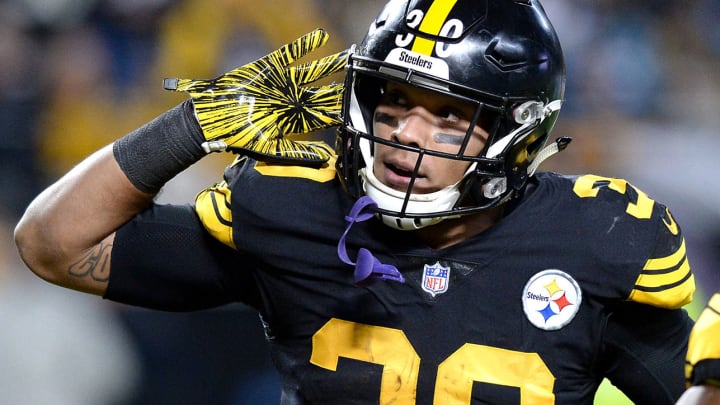
The auction format is becoming a more popular format each year and with good reasons. I believe it is the best format which takes away the intrinsic bias of draft position on the outcome of many leagues. In an auction everyone has the same chance to procure each player based on their individual assessments of the player’s value vs. their cost in the auction they are participating. The team that acquires the breakout player believed in them the most or at least was willing to spend the most money on that player.
If you are successful in an auction, you can build a better team than you can in a draft. A couple of years ago I had the highest scoring team in the FFWC regular season and was also the top auction team. My contest leading fantasy team (~500 teams) scored less than my league-leading auction team (12 teams). This was somewhat unique, but it is very common the top teams in an auction are better than top teams in a snake draft.
When you think about it, it makes sense. Just because you might be the most bullish on Alvin Kamara this year, for example, doesn’t mean you’ll get him if you are drafting from the back of round 1. The same could be true if you’re a big fan of Amari Cooper. You likely don’t grab him on the first turn but he’s not going to get back to you on the turn in the third/fourth round. Your player rankings in a draft don’t impact your roster construction in the early rounds as much as ADP.
But the real reason you’ll want to play in an auction is the fast pace excitement of the game. This is akin to playing football vs. baseball. On the football field, you’re active on each play regardless if you touch the ball. In baseball, you might be out in right field and it could be innings between you getting a ball hit in your direction. This is like being on one of the ends of the draft where you’ll make two picks then wait for 20 minutes before your next turn comes around.
In an auction you’re always active and you never know when you’ll enter the fray depending on who’s been nominated and where the bidding is at. If you’re inattentive you risk making a mistake and allowing a player to go for value to one of the competing owners.
The following is a primer for auctions. I’ll talk about:
• Preparing for an auction
• Some in-auctions strategies
• Provide auction values based on current high stakes ADP
Preparing Your Own Auction Valuations
Having an internet auction list is like an ADP list off the internet and it will likely serve as a good guide to player value. The fantasy football universe is large and diverse and likely the average auction values and ADP data will provide a solid framework for the types of values put on players in your auction. However, in a draft, the ADPs for the front end of the draft are largely unaffected if a league drafts 16 players or 20 players per team. For example, in 2018 Todd Gurley or David Johnson likely got drafted within the top few picks. For an auction, these two would likely still be among the top priced players; however, what is the difference in that top price point if there is a roster size of 16 or 20? Is there a difference in the price?
With an auction, let’s look at two different league formats. Both have a $200 budget, but one league requires you to fill a 16-player roster and the other requires you to fill a 20-player roster. Also, one is a 10-team league the other is a 12-team league. In other words, one league will roster 160 players and the other 240 players.
The value placed on the 80 players not auctioned off in the first league is likely going to be ~ $1. each. That impact is understood. The larger impact is where does the $80 come from? Either (a) the values of the top players get reduced in the 20-team league or (b) the slope from the top players to the $1 players increases meaning there will be a lot more $1 players. Because of this, looking up an auction value from one site might give you very different numbers than another site. Preparing your own valuations ensures you understand the true value of the player based on your rules and roster requirements.
For this reason, I like a quantitative system for what value I place on a player in addition to what value I think the market will place on that same player. For example, every year there are over-hyped rookies or favorite sleepers that everyone loves in addition to the still solid, yet aging veterans that don’t seem to get much love. There are also players that each owner plans on avoiding at all costs – those are easy to assign a $0 value to, indicating you will not bid on that player. But, what would you have paid for Odell Beckham in his rookie season? Did you believe the hype? If you assign your own values putting in your belief on his performance, then those values are determined based on your projections of how the player will perform. Once you’ve convinced yourself you’ve properly modeled the point values each player can deliver to your fantasy team, you’ll be more apt to hold to the auction values you’ve assigned to each player. When you’re bidding on players, you’re really bidding on a set of point values and risk of achieving those points for your team.
One of the trickiest issues is to determine the relative worth of players playing different positions in an auction setting. Intuitively everyone knows the top RB should be worth the most money because they typically get drafted first. The top RB in the FFWC format typically has scored > 350 pts. The top QB typically scores > 400 pts and the top WR typically scores > 300 pts.
The following is a methodical process to come up with the auction values.
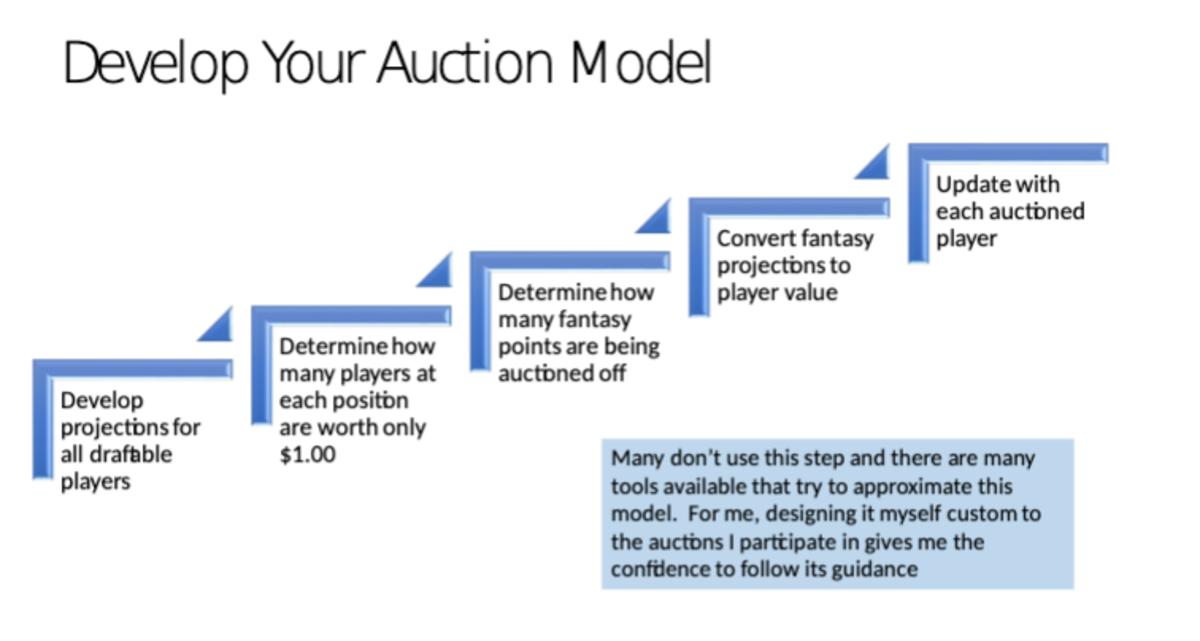
Step 1: Determine your performance projections
Do this step for all 240 players that will be auctioned off. This sounds difficult, but FullTime Fantasy does an excellent job of providing projections for you. Sort this list by position.
Step 2: Determine how many players at each position are worth $1.
For example, in the FFWC format, 12 teams compete in each league with a roster size of 20. There are 11 starting positions (1 QB, 2 RBs, 3 WRs, 1 TE, 2 Flex, 1 D and 1 K). In an auction, it’s likely that a large percentage of the players auctioned off go for minimal $1 or $2. price. Many times, an owner will pre-empt owners from taking a certain handcuff running back or deep sleeper WR or marginal tight end by nominating them for $2. knowing most owners wouldn’t go to $3 to steal them. Obtaining average auction valuations using the internet can give you a feel for where in the rankings QBs, RBs, WRs etc. will go for these minimal $1 and $2. bids. Since auctions aren’t as popular as drafts, obtaining and filtering this data is a little more cumbersome than working with average draft positions, but the data’s out there and you can approximate who you think will go for minimal bids given this data with a little intuition and experience mixed in.
For example, looking at auction data from various sites prior to the FFWC auction last year, there were 41 unique RB’s that always had assigned values higher than $1 and there were 63 RB’s that had received a maximum bid greater than $1. That means the likely maximum RB rank that you’d assign a $1 value would reside between the 41st RB and the 63rd RB. The auction I participated in at the FFWC had 50 RBs receive a price higher than $2 and 64 had received a price greater than $1. A similar analysis is performed at each position to give you these baseline players. Note the difference in the average auction values vs the actual FFWC values. This, in part, is because most auction leagues auction off fewer players than the FFWC. This can be frustrating, but it also provides you with an opportunity to obtain a competitive advantage. Let’s assume the following:
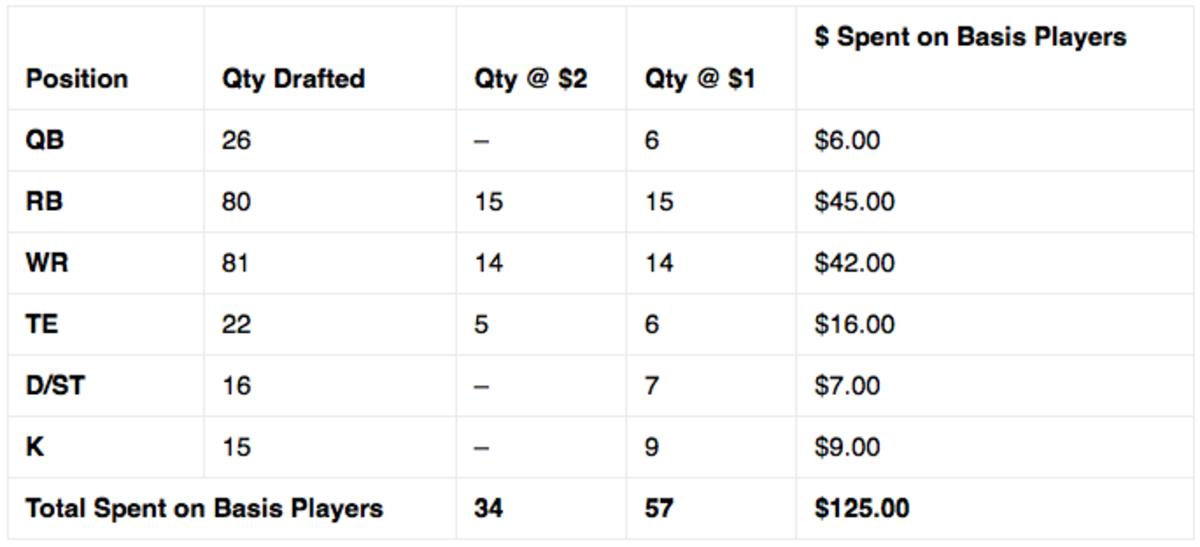
You have now assigned a value for perhaps 91 of the 240 players that will be auctioned off. You’re over one-third of the way done! What you’ve also done is effectively declared that the other 149 players will be competed for with a pool of money of $2,275 (12 teams with $200 =$2,400 less 57 players at $1 each and less 34 players at $2 each = $2,275).
Step 3: Assigning Value
Now you have your basis $1 and $2 players at each position. Every player who outscores these players in your performance projections has value to your team. But how much value is the key question?
One way to determine this value is to add up all the points available above the basis players and assign an equal dollar value per point available. For example, you might have 8,200 points available for bidding distributed by the names of the various players. The league will start with a total budget of $2,400 (12 teams x $200 / team). If 91 players were assigned a value of $1 or $2 value totaling $125; that leaves $2,275 available to bid on the remaining 140 players. However, since each player has a value equal to or greater than $2, you need to subtract from this pool of money $1 per player so when the value is assigned it can be adjusted up by $1. This leaves you with $2,135 to use when translating value to dollars.
So how much is Christian McCaffrey or Aaron Jones worth? The trick is to figure out how many points above the $1 player they are projected to offer to your team. For example, McCaffrey might be projected to score 350 pts and Jones could be projected to score 200 pts and the $1 player is projected to provide you 100 pts. That means McCaffrey is providing you 250 pts (350 pts – 100 pts) of the available 8,200 pts that are out there. In that scenario he’s worth 250/8200 of the pool of money ($2,135) or ~ $65+ $1 = $66. Jones is worth (200-100)/8200 of the same pool of money ($2,135) or ~ $26 + $1=$27. If you did this for each player, you would then have a player budget assigned. It’s interesting to then compare it to the average auction values that you’ve obtained.
Let’s look at WR now: Let’s say Michael Thomas has 300 projected pts and Amari Cooper has 250 projected pts. The $1 WR is worth 150 points (note the significant difference between WR and RB baseline players). That means Thomas is worth 150 pts (300-150) and that equates to an auction value of (150/8200)* $2,135 = ~ $39 + $1 = $40. Cooper’s 250 pts is worth (100/8200) * $2,135 = ~ $26 + $1 = $27.. For one final comparison, consider QB: The baseline ($1) QB might provide 300 points. Patrick Mahomes is projected to provide 400 points ((400 pts – 300pts) / 8200 pts)*$2,135 = ~ $26 + $1 = $27. Kirk Cousins might be projected to score 310 points which provided ((310-300)/8200) * $2,135 or ~ $3 + $1 = $4.
How these values change during an auction:
Example in a two-player league format:
For illustration purposes, let’s assume there are only two owners in the league and the league plays a single game. Also, for further simplification, the player performance results are known ahead of time. You now need to assemble a starting roster of 1 QB, 1 RB, 1 WR and 1 TE given a $100 budget and the available choices along with their actual performances and you must acquire 6 players in the auction:

Since each of the two players need 1 QB, 1 RB, 1 WR and 1 TE we know two of each will be awarded in the auction. Your basis players will be the 3rd player at each position. So, we’ll assign their value as $1.
The total auction budget is $200 ($100 for each of two fantasy GMs). 12 players will be auctioned off. Four of which you just assigned a value of $1. This leaves you $196 for 8 players. So we’ll determine the value of the other players by determining the value they bring to your team in relation to the total value available or:
(Player A’s Value/Total Value) * ($196-8) + $1 = Player A’s Fair Price
So let’s now assign a point value for each player above the basis player at their position and you’ll come up with something like this:

Total points being bid on is: 50 points. Therefore, QB1’s value is: (11/50)*($188)+$1 = ~ $42
Using that same formula, here are the results of the other players:

The total value in the table above sums to $200 which gives us a value for every auctioned player. If both fantasy GMs use the above table to set their budgets, the starting rosters could end up like this:

Not so coincidently both owners who used the same system obtained the same value for their $100 budget.
Now, let’s assume both teams target obtaining QB1 at all costs. The demand for QB1 spikes and Team 1 acquires QB1, but this time for $58 instead of $42.
The auction has now assigned a fifth player’s value (the four $1 players being the others). The fifth player’s value is input as $58 and that changes all of the above assumptions. 11 value points have now been auctioned off leaving you with 39 value points remaining. Instead of $196 dollars to spend on eight players, however, the league now has a total of $138 to apply to seven players so the value for each point changes as follows, using the same formula except with QB1’s value fixed at an inflated $58:
(Player B’s Value/Total Value) * ($138-7) + $1 = Player B’s Fair Price

Predictably, the extra money spent on QB1, lowered the value of the remaining players and put Team 1 into a difficult cash position. Team 1 can no longer outbid Team 2 for any of the top players at their positions, so the teams’ starting lineups could now look like this:

Clearly Team 2 was able to use Team 1’s over exuberance in spending on QB1 to his advantage in the auction and was able to now win the game by locking in three of the four top starters.
The above was a simple example of two players with small rosters and known results in order to demonstrate the process. A fantasy football league includes many more variables. Going into 2018, for example, no one would have dreamed of spending more for James Conner, for example, than for Le’Veon Bell. Had that happened, the Bell owner would have thought to have had a significant advantage. As it turns out the opposite was true. Anything can happen in fantasy football.
In-Auction Strategies
Ok, now that we have developed our budget for each player and we will try to be disciplined to adhere to the budget, there still needs to be some general overriding guidelines that need to be applied.
I summarize my guidelines in the following figure.
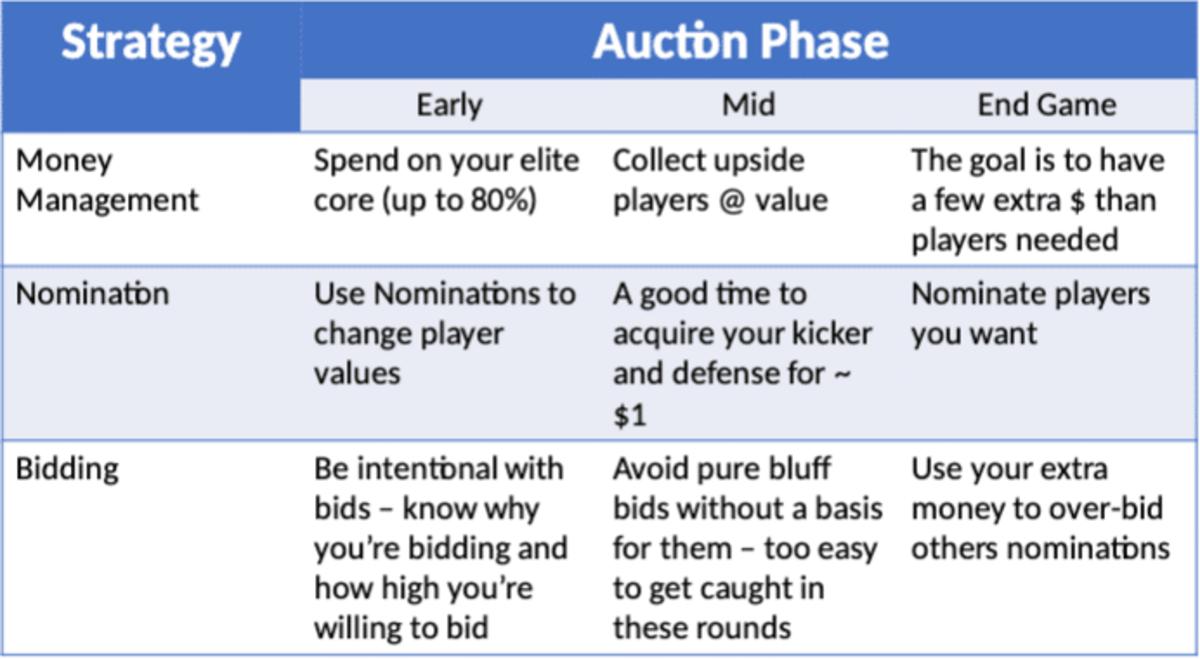
Remember ~40% of the players will go for $1 or $2 and ~ 70% will be auctioned off for under $10. Therefore, if you stay out of the high end of the auction, your bankroll will be oversized for the talent remaining in the auction – encouraging you to overbid for players and/or have cash left at the end of the auction.
• Keep good records. This is a must for a successful auction in a competitive league. You need to know the minimum bids both you and your competition can make for players. You need to know where the various need levels are for each team and who’s left to be auctioned off. Is the current player being bid on the last of a tier (thereby increasing his demand)?
• Have a nomination strategy. First, many auctions will penalize you $1 from your auction budget if you don’t submit a nomination quickly (within 10 seconds) when it’s your turn. You don’t want to incur this penalty. More importantly, however, is to develop a strategy which helps you achieve your auction objectives by nominating key players.
Simple strategies for nominations include:
• Get your kicker / defense early to have your pick for $1 – $2
• Nominate hyped players you don’t believe in when money is available
• After you’ve invested heavily in a position, start nominating that position to keep the demand rolling for those players you no longer have a strong interest in acquiring
• Change player values
A good strategy to cause money to be overspent (thereby changing player values) is to nominate a player who is clearly short of the top player in value at his position. The cap on his value won’t have been set yet, since the top player hasn’t been nominated and his ending auction value now sets a floor for the truly elite players.
For example, the following were the auction values by QB rank in two auctions I played at the FFWC that were ~ 24 hours apart. Many of the same auction participants were in each auction. Yet, the timing of the nomination of QB3 markedly impacted the auction prices of the entire QB position. The graph below demonstrates this phenomenon.
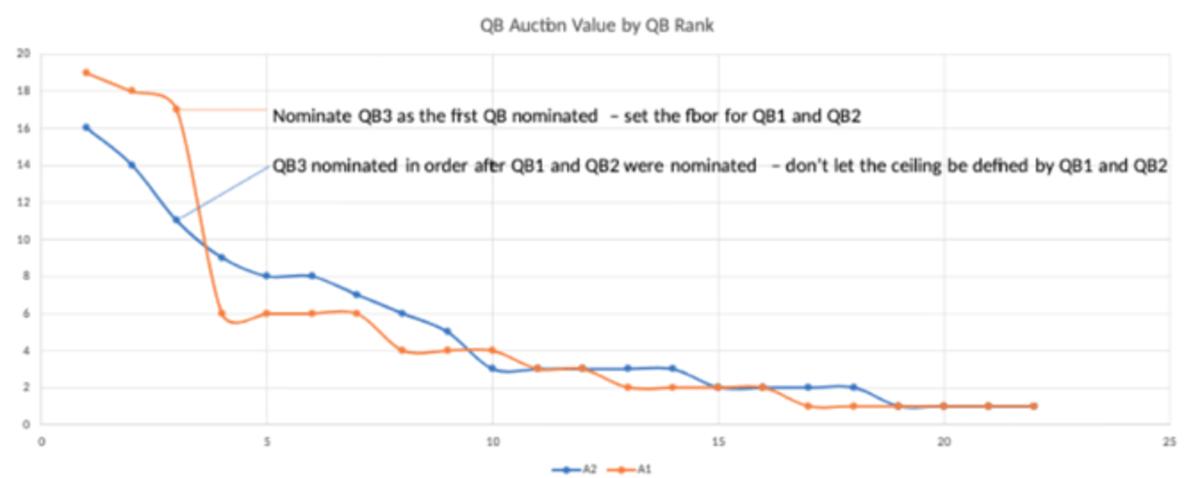
Auctions are really fun and exciting and those players that truly enjoy understanding roster construction and player valuations can gain an edge in an auction that cannot be gained in a draft as easily.
Auction Values based on ADP
For this article, let me default to providing some guidance on valuations of players based on ADP. The X axis below is the ADP of a player and the Y axis is the market price at auction for that player. I’ve graphed two auctions I played in to show you that, there are some differences in each auction, but predominantly the same curves apply.
This is what I typically use as the ‘market’ price for players in an auction. Once you know their ADP or even draft round you can quickly figure out the Min / Max values you should pay for these players. Reference the figure below for the costs of the players typically drafted in the first eight rounds.
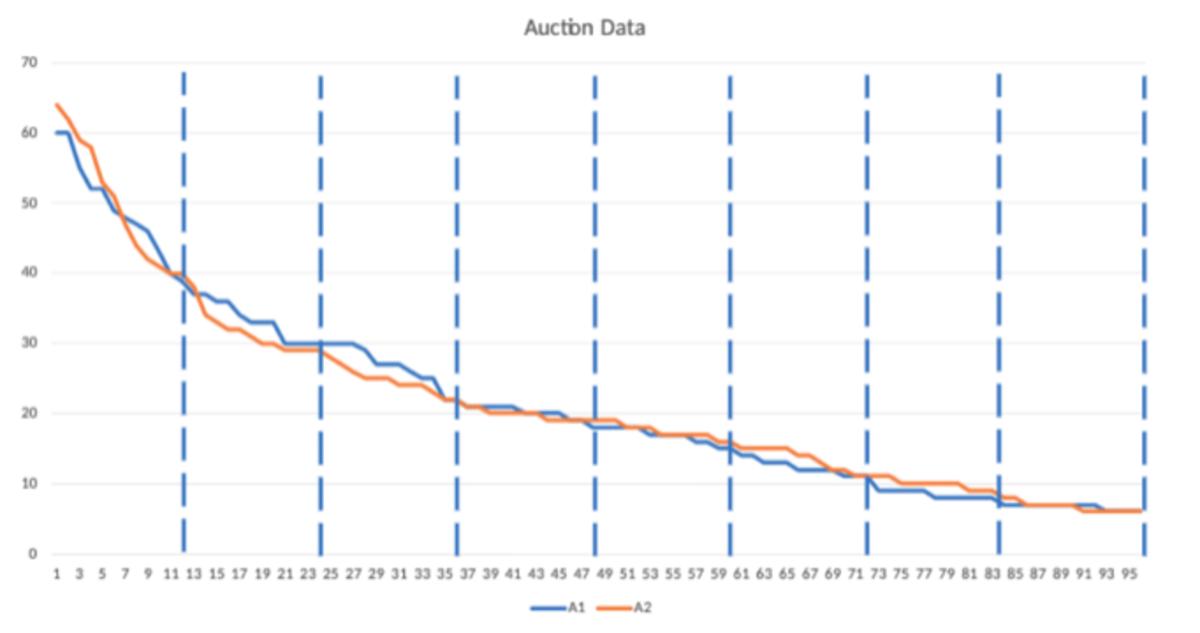
For example, the top four RBs will likely be auctioned off at the higher end of the market for a first-round player ($39 to $60). As you can see, a player with a fourth-round ADP might be auctioned off between $18-$22.
If you keep these generic figures in mind, you can quickly assess if the auction is providing you a discount on a player or asking for a premium. You’ll then have to assess if the discount is deep enough for you to jump in on the player or if the premium steers you away from a player you were coveting.
